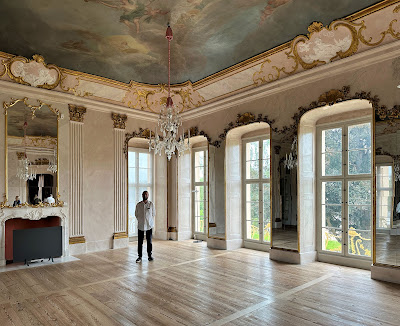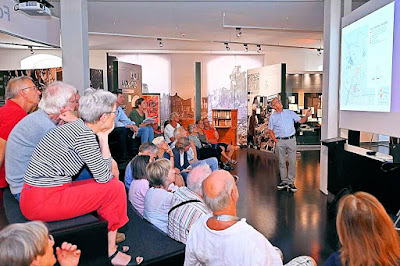Under Napoleon, Hövelhof became part of the Kingdom of Westphalia, with Kassel as its capital.

|
| Der Code Napoléon pour le Royaume de Westphalie |
I lived in Hövelhof from July 1944 to fall of 1945 and went to elementary school there.
Before that, our family was in the Sudetenland, but as the Russian front in the east drew closer, my father thought it would be better if we lived further west.
He knew someone in Westphalia, Karl Epping, the uncrowned king of Hövelhof. Epping owned a meat processing plant and a sausage factory in the village. In 1944, he started with the help of Russian prisoners of war building accommodations for evacuees and bombed-out people far outside the village center. Today, the still-existing settlement is called Eppinghof.

|
| Did my father buy the Westfälisches Volksblatt? (Click to enlarge) |

|
|
We lived on the upper floor of the second house from the right. My mother, wearing a white apron, looks out the kitchen/living room window. |
My father soon had to say goodbye since, as a specialized engineer, he had to continue in the distant Sudetenland to ensure the functionality of the X-ray facilities, which were frequently damaged by war impact.

|
| Little Manfred, my mother, and my brother standing at the entrance door |

|
| A row of finished Behelfsheime (temporary (?) accommodations) |

|
| The secret of reconciliation is called memory. |

|
| Forced laborers and prisoners of war in the Third Reich (©Körber Stiftung) |
The first lesson in the morning was always devoted to religious education because Hövelhof belongs to the Archdiocese of Paderborn. In German, the comparative and superlative forms of the adjective "black" are jokingly Münster and Paderborn, where the color black stands for Catholicism.
It was taken for granted that pupils attended the Holy Mass at 7 AM before classes started at 8 AM. My walk from the settlement to the village school and the church next to it was over half an hour, so my mother had dispensed me from attending early mass.

|
| The type of classroom I remember well (©Schulmuseum Riege near Hövelhof) |
The teaching program of my year was so simple that I was more interested in the lessons for the older years. In religious education, I was the best anyway because I owned a children's Bible and had read it at least three times in the absence of other books, which I had to leave behind in the Sudetenland.
In the fall of 1944, I transferred to the "upper" section of the village school.

|
| My blond-haired brother is in the foreground. |
And then they came. Silver air fleets of the Americans flew over Hövelhof at a great height. The planes hummed, glittered in the sun, and dropped strips of metal foils to interfere with German Radar. These strips we children collected as Lametta for future Christmas tree decorations.
Once, we children experienced a high-up dogfight. Suddenly, plane parts fell from the sky. We took refuge in a nearby copse, held our breaths, and prayed many "Our Father."

|
|
The house that protected us. Red Baron is sitting on the right, directing the crowd. |
The war was over, my father had eventually made his way from Sudetenland to Hövelhof, and we, in our best clothes, had a photo taken on the edge of the forest in the summer of 1945. Although living in poor conditions, our family was overjoyed to have survived the war unharmed.

|
| Here are the brothers with a friend and a better view of the houses of the Eppinghof |
The atmosphere between the villagers and the inhabitants of the settlement deteriorated. I remember well that one Sunday, this same chaplain announced from the pulpit, "Those of you who put your feet under our tables," creating a pogrom atmosphere. Nothing happened because the settlement was too remote, far from the village.
In the fall of 1945, my father took me to Hamburg, where I attended secondary school while my mother and brother remained in Hövelhof. I slept in my father's office until he found appropriate housing for the whole family. But that is a different story.





















_02.jpg)

















